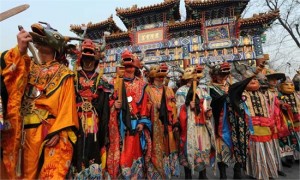I was delighted to see that longtime commenter Kevin Carrico has translated into English Tsering Woeser’s book Tibet on Fire: Self-Immolations Against Chinese Rule, and a generous sample has been published in the NY Review of Books online. The article helped me understand why these Tibetans light themselves on fire and what they are hoping to achieve. It comes down to politics.
In my interviews with international media on the topic of self-immolation, I have always tried to emphasize one area of frequent misunderstanding: self-immolation is not suicide, and it is not a gesture of despair. Rather, it is sacrifice for a greater cause, and an attempt to press for change, as can be seen in these two peaks in self-immolation. Such an act is not to be judged by the precepts of Buddhism: it can only be judged by its political results. Each and every one of these roaring flames on the Tibetan plateau has been ignited by ethnic oppression. Each is a torch casting light on a land trapped in darkness. These names are a continuation of the protests of 2008 and a continuation of the monks’ decision that March: “We must stand up!”
Tibet is always a tricky topic to blog about because it is so not black and white. It’s important to understand how the majority of Chinese see Tibet and how they wonder why Tibet would recoil from its supposed benefactors. The Han have built schools and roads and hospitals, ended serfdom and raised the standard of living for thousands of Tibetans. Why then do so many Tibetans see the Chinese as oppressors bent on snuffing out their culture, even their language? The reality of life in Tibet is far different from that imagined by so many Chinese people. Maybe the Tibetans really were “liberated,” but many of them ask, “Liberated by whom? Liberated from what?” This fine translation sums up their despair.
After the 2008 protests, a “patriotic education” program, forcing monks to denounce the Dalai Lama openly, was intensified and expanded beyond Lhasa to cover every monastery across Tibet. Outside of the temples, the people of Tibet face regular searches of their residences: images of the Dalai Lama are confiscated from their homes, and there have even been cases of believers being imprisoned simply for having a photograph of His Holiness.
Second, the ecosystem of the Tibetan Plateau is being systematically destroyed. The state has forced thousands to leave behind the sheep, grasslands, and traditions of horseback riding with which they have practiced for millennia to move to the edges of towns, where they remain tied to one place. In their wake, a sea of Han workers has arrived from across the country armed with blueprints, bulldozers, and dynamite. They have immediately gone to work on the empty grasslands and rivers, mining copper, gold, and silver, building dams, and polluting our water supply and that of Asia as a whole….
So how should we feel about Tibet? As I said, it is a very tricky subject, and I have always exercised a good deal of caution while writing about it. I have never advocated that Tibet be made an independent nation and I have criticized articles in the media that I see as biased against Tibet, only offering the point of view of the Free Tibet crowd, while there is more to the story than that. On the other hand, I’ve never congratulated the CCP for generously helping Tibet end serfdom and get on its feet. That, too, is simplistic.
Pieces like this remind me of just how harsh China treats Tibetans, to the point where more than 140 of them have chosen self-immolation since 2008. Like under apartheid, Tibetans are second-class citizens to the Han Chinese, and typically, the CCP responds to unrest only by making the oppression worse, to the point of not even allowing Tibetans to make photocopies, lest they make and distribute copies of anti-government literature. I want to be fair in my blogging about Tibet, but no matter how much I strive to remain unbiased, the stubborn facts remain: Something is terribly wrong, and the Chinese government bears direct blame for treating an entire class of its people as second-class citizens and worse.
Please read the entire excerpt. It is obviously told from the point of view of a supporter of the Dalai Lama, but it sheds important light on the steadily tightening of the screws on the Tibetan people and offers great insights into what is motivating these people to make the ultimate sacrifice for their ideals and setting themselves on fire. Congratulations to Kevin for this fine translation.

Comments